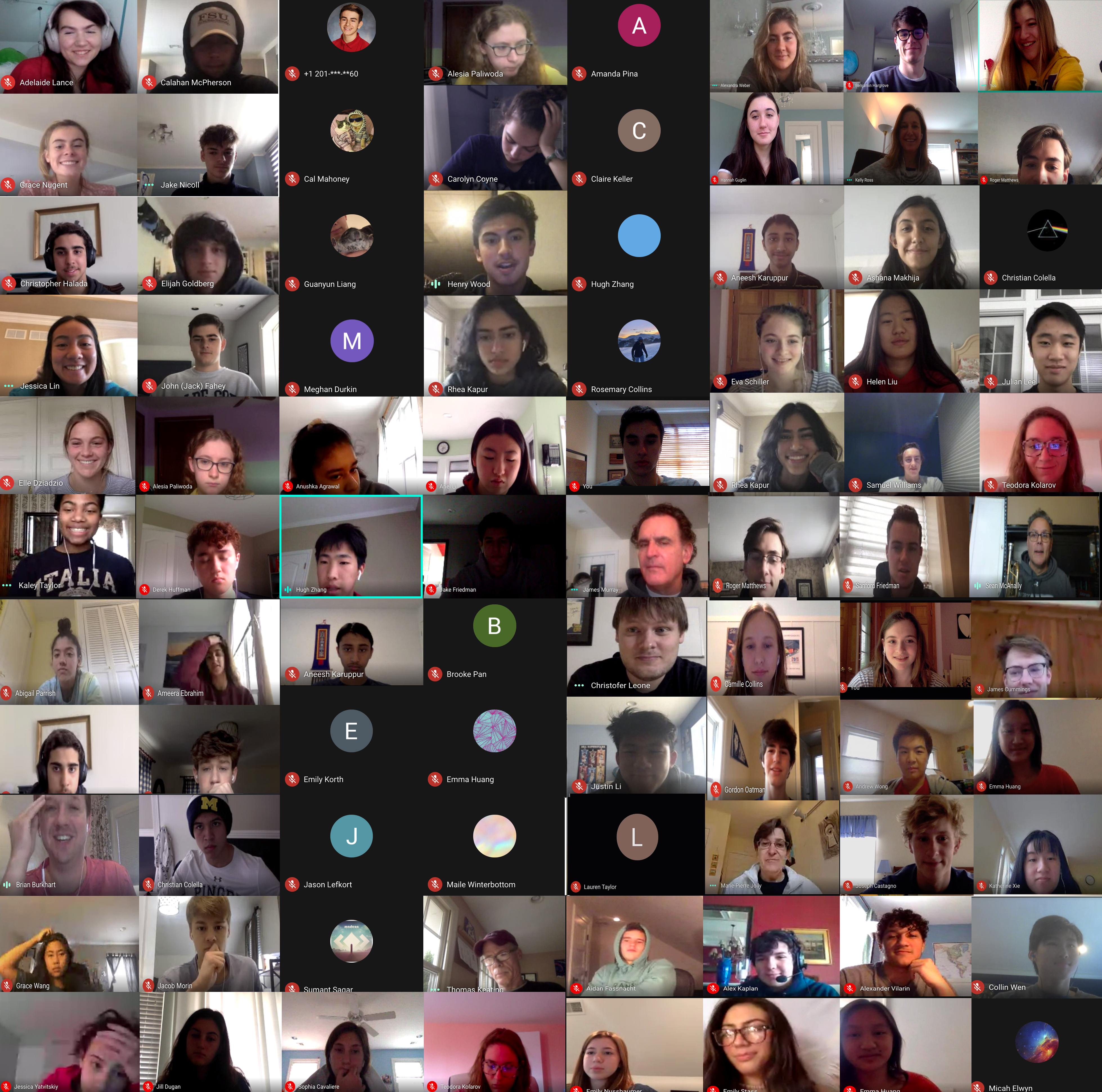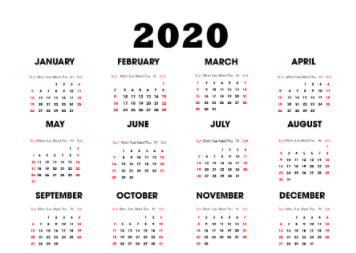
Feb 16, 2021 | COVID-19
By Sophia Lewis (V)
The entirety of 2020 was definitely one for the history books, but when I think back to the past year, I think of January and February most––the two months before the pandemic hit full-force. Almost one year ago, the first case of the coronavirus was diagnosed in the United States. Though a serious matter, the general public was naïve to what this meant, as COVID-19 still seemed to be “that virus ravaging China.” By February, I saw only a couple of people wearing masks in public, and the only thought crossing my mind was: “Why are they wearing masks?” More time passed, and instead of reading the news and worrying about what COVID-19 spread actually meant, I was preparing to perform in Pingry’s rendition of Chicago and participate in my first year of serenades with the Balladeers. On March 13, however, all my plans halted.
The year turned around completely. The day I was supposed to be packing my suitcase for the annual Disney trip with the softball team, I was buying extreme amounts of toilet paper and groceries with my mom, still grieving over the fact that school would be remote for a month. Nobody knew what the future would hold; instead of enjoying spring activities, concluding yet another tedious school year, and readying ourselves for the much-anticipated summer break, we were shut up in our homes with nothing to look forward to, except trying to figure out what exactly remote school was and wondering where exactly the mute button on Google Meet was. On the last day of school, instead of feeling triumph, I felt tired. Instead of going to the beach, seeing friends at camp, or travelling with our families over the summer, we had only one option: online programs, and the furthest traveling we did was to the kitchen.
After what seemed like a never-ending summer, Pingry announced that they would be inviting students back to school in person, and I was thrilled. Although optimistic about my first day back in September, I remember the day as bleak, as everything I’d liked about school had been eliminated. After the conclusion of the day, I had heard the phrase “new normal” so much, I could’ve screamed. Lunch, which was once an enjoyable time for eating and socializing, was now a challenge, as communicating with friends through the plexiglass barriers proved to be an impossible task. The worst of it all, however, was that I didn’t truly mentalize being a junior, as I had never gotten a proper conclusion of sophomore year.
After looking back at the year, the prevailing question is this: where are we now, one year later? We arrive at school in masks, attend class with plexiglass barriers, and socialize with social distancing. Most contact sports and extracurriculars have been delayed or canceled, but others activities move forward, with restrictions, of course. All activities, in and out of school, have had complete structural changes. Eating at restaurants or going to see movies with friends are activities of the past. Concerts, baseball games, or just about anything with a large crowd involved are nothing more than a mere memory; just the sight of a large crowd is enough to scare people back into their homes.
Despite the challenges, the pandemic is in a different spot now than it was one year ago. We now have two vaccines that have been approved and have begun being administered to the public. In addition, after a year, mask-wearing has become the “norm”. While it can be argued that any “silver lining” pointed out about COVID-19 at this time is not very promising, I do believe that there have been some once-in-a-lifetime opportunities during this pandemic era. So, with our masks on, let’s look for the light at the end of the tunnel.
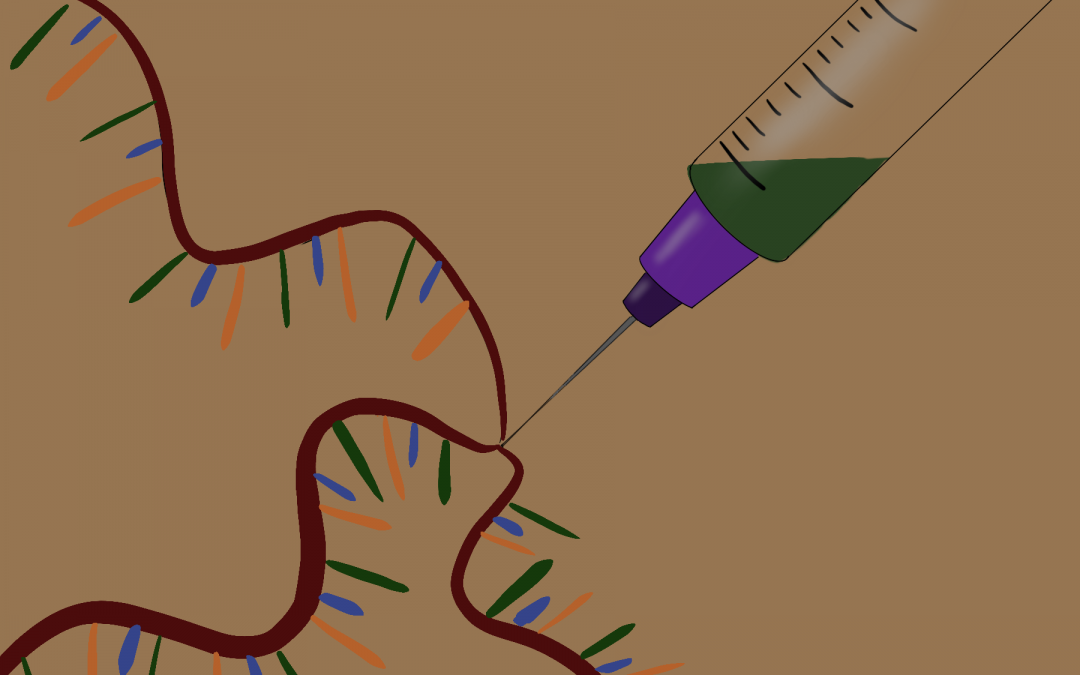
Dec 11, 2020 | COVID-19, Investigative
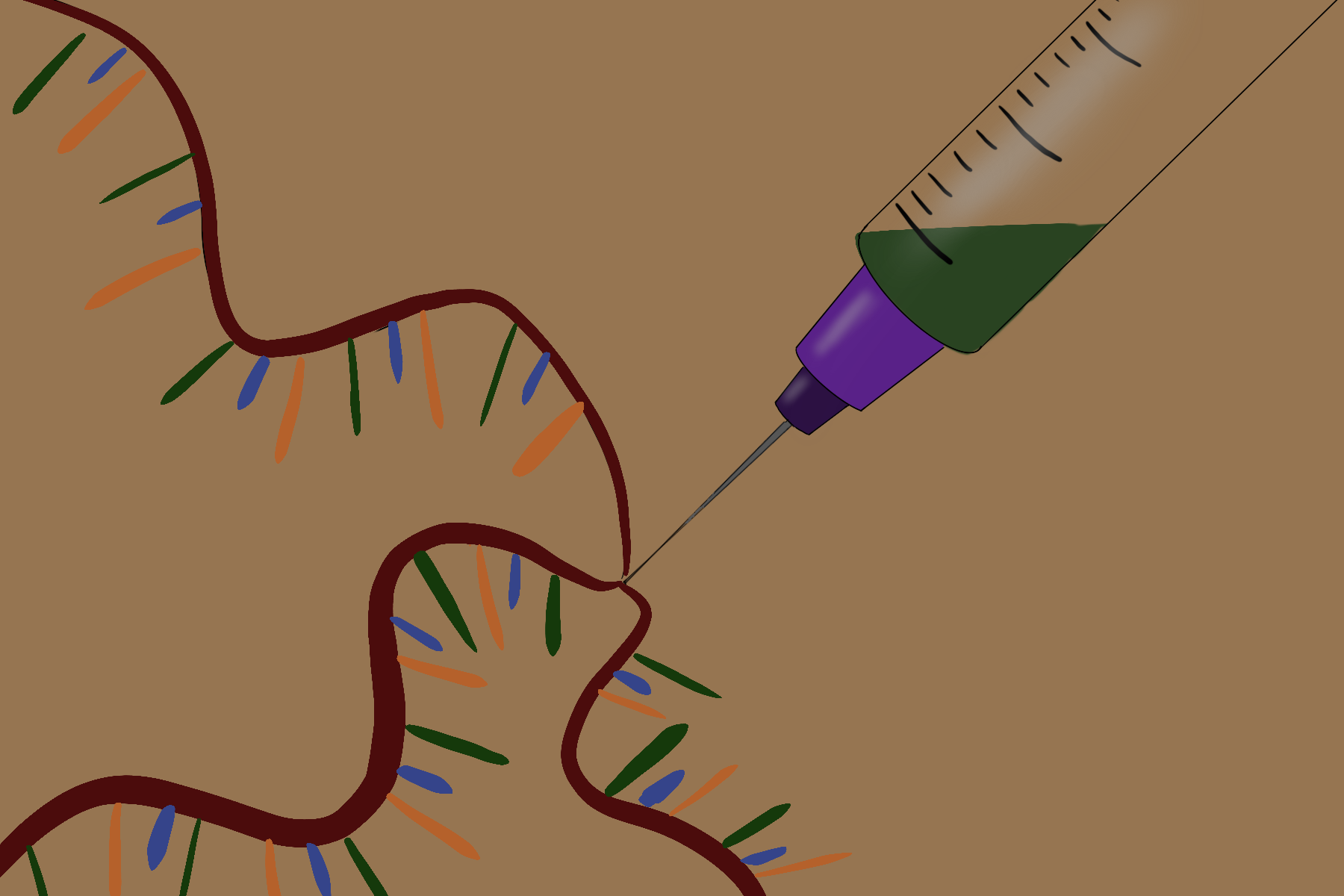
By Evan Wen (IV)
Can a COVID-19 vaccine bring life back to normal? Early data suggests that certain vaccines could be the answer to this question. However, the Centers for Disease Control and Prevention (CDC) has a long and elaborate process for approving said vaccines. The process begins with an exploratory and preclinical stage, followed by clinical development; within the latter is a three-phase process. Phase I includes small groups of people receiving the trial vaccine. In Phase II, the vaccine is given to groups of people who fit a target demographic. For the final phase, the vaccine is given to thousands of people to test for both efficacy and safety. Once the vaccines pass Phase III, companies must receive approval from the FDA before manufacturing and mass-distributing the vaccine. Once the vaccine is distributed, the Vaccine Adverse Event Reporting System monitors the side-effects. As of November 24, 2020, five companies––AstraZeneca, Jannsen, Moderna, Novavax, and Pfizer––are going through or plan to go through Phase III clinical trials.
When infected with COVID-19, it takes several days for a person’s body to recover from the infection. During this recovery period, the body creates the necessary tools to fight off the infection and the immune system proceeds to store information about how to protect the body against COVID-19 in the future. The vaccines allow the body to produce the necessary white-blood cells to attack the virus and defend itself from infection without contracting it.
There are three types of vaccines that are currently in Phase III of clinical trials: an mRNA vaccine, a protein subunit vaccine, and a vector vaccine. The mRNA vaccine contains genetic information that allows the virus to create a specific protein that lets the body make copies of said protein. When infected with COVID-19, the body will detect this protein and create white blood cells that will fight off the virus. Meanwhile, protein subunit vaccines harness pieces of proteins from SARS-CoV-2 (the virus which causes COVID-19), and, similar to the mRNA vaccine, the body creates white blood cells to fend off these proteins. Finally, vector vaccines contain a weakened version of the live virus that the body then uses to first learn about COVID-19 and create the defensive white blood cells thereafter.
Moderna and Pfizer Pharmaceuticals have released data from Phase III trials, both companies planning to release mRNA vaccines with approximately 95% success rates. In trials done by Pfizer, patients were analyzed 21 days after being given their vaccine whereas Moderna analyzed its patients 14 days after administration, and results show that both vaccines have had little to no side effects. A major difference between the two vaccines, however, is in the way they must be stored in order to maintain efficacy. Pfizer’s vaccine must be stored at -112 degrees Fahrenheit for up to 5 days, requiring special freezers found in labs and hospitals. In stark contrast, Moderna’s vaccine can be stored between 36 to 46 degrees Fahrenheit while being able to stay in the refrigerator for 30 days. As both vaccines wait to be approved by the FDA, both companies begin to make plans for widespread distribution.
Our community has taken drastic measures to slow the spread of COVID-19 by wearing masks and staying socially distant. By continuing the current safety measures and following the CDC’s recommendations––especially as vaccines are approved and distributed––the return of normalcy may soon be upon us.
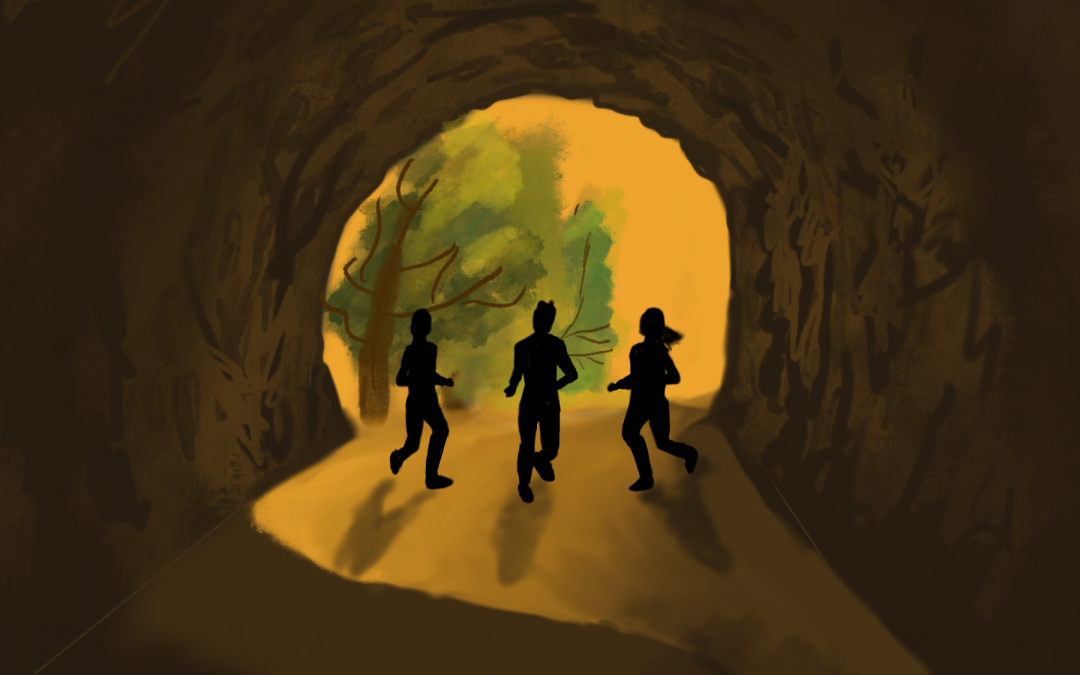
Dec 10, 2020 | COVID-19, Emma Drzala, Opinion
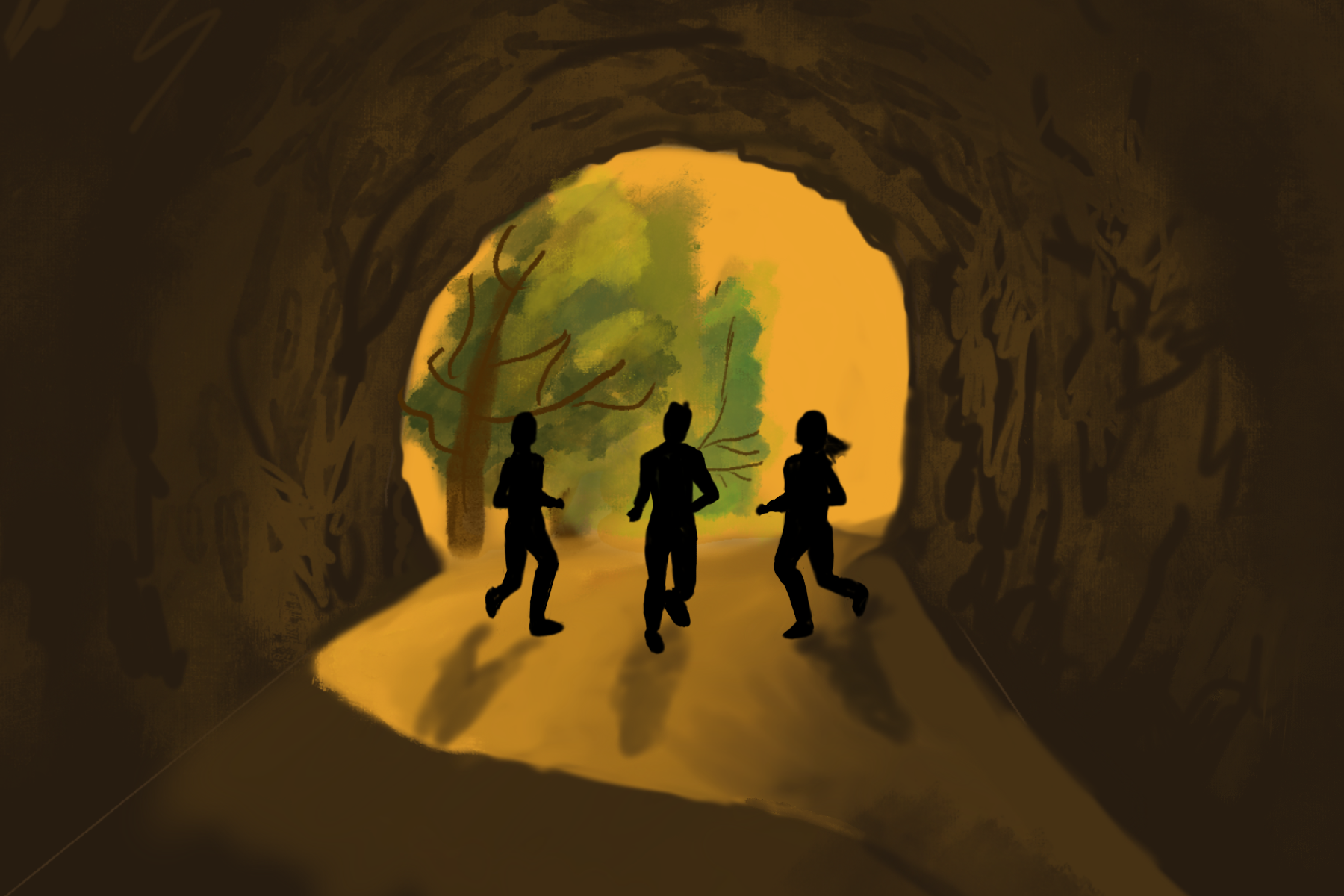
By Emma Drzala (V)
March 13, 2020: a day that will never be forgotten, not only at Pingry but across the nation. On that day, Pingry students were celebrating the news that school would shut down for a couple of weeks following spring break, as a result of the COVID-19 pandemic. Everyone was naïve to the situation around them; nobody could truly predict what was to come. We all thought we would be back in school by April or May, and that the shutdown was just a two-week extension to our break. We all gleefully walked out of school, not knowing that we would not return for half a year.
Two weeks turned into a month. A month became three months. School got out. Summer passed. Still, no end to the pandemic in sight. We came back to school with masks and shields. Still, no sign of the pandemic being over.
Just as we were prepared to give up all hope and accept the fact that the pandemic was our new normal, and that we would forever be confined behind our masks, shields and plexiglass prisons, Pfizer Pharmaceuticals announced a groundbreaking development on November 9th: they had finished developing a vaccine with a 95% effectiveness rate.
After the initial excitement surrounding this positive news died down, my mind bustled with questions. I wondered when the vaccine would be available to the general public, how many people would actually trust its reliability, but most importantly: would life finally, after so many agonizing months of quarantine, return back to normal? Would I finally be able to walk into school without scrambling to finish my pre-screening form? Could I finally eat lunch with my friends without being reprimanded for sitting less than six feet apart?
Although on first thought, the vaccine seemed to be the ultimate end-all for this virus, I realized that this was simply wishful thinking after months in quarantine and away from my friends.
We have to acknowledge that a vaccine may not live up to the hefty expectations the American public has placed on it. There is a high probability that mask-wearing and social distancing measures will still be enforced. During this pandemic, I have longed for a return to school in-person, and the empty and frankly depressing experience of online learning has only cemented this desire even more. The media and our politicians love espousing how the COVID vaccine will prove to be a silver bullet to the entire pandemic and ultimately, this mess of a year. But, let’s be pragmatic here. I do remain optimistic that this vaccine will bring back a degree of normalcy to our lives. Having a portion of the population, especially our most vulnerable citizens (seniors, frontline workers, doctors, etc.), will significantly mitigate the most serious risks of the disease. But with such limited distribution currently, this vaccine is no magic wand. If we take a look at the maladies of history that humanity has successfully defeated, such as polio, measles, and smallpox, nearly 80% of the population had to be vaccinated or develop immunity in order for these diseases to be vanquished. If we are to reach the said 80% of herd immunity, issues with storage and production, along with a sizable population of Americans unwilling to take the vaccine due to its experimental nature, will persist for weeks and months after the vaccine first comes out. These issues certainly hamstring our efforts, leaving a significant portion of the population vulnerable for quite some time.
So as pharmaceutical companies and the FDA begin the long-awaited distribution of vaccines, we must not fall into the trap of believing that we are entirely done with this horrible virus. Yes, there is a light at the end of the tunnel, and it is a miracle of science that American pharmaceutical firms have been able to develop the vaccine in such a short period of time. It is tantalizing to let down our guard at this juncture. But we cannot. We must be aware that until virtually every person in the United States has received the vaccine, COVID and the resulting regulations we have come to loathe this year will still linger. So let’s stick to these rules for just a couple more months and not let our guard waver. We have been forced to endure these rules for a year already, so several weeks will not hurt. We will be back together soon with our friends, under the sun, with no masks on and not socially distanced.
We are almost there. We just need to keep it together for this final sprint. Wear your masks. Spread out. Stay safe. There is finally a light at the end of the tunnel.
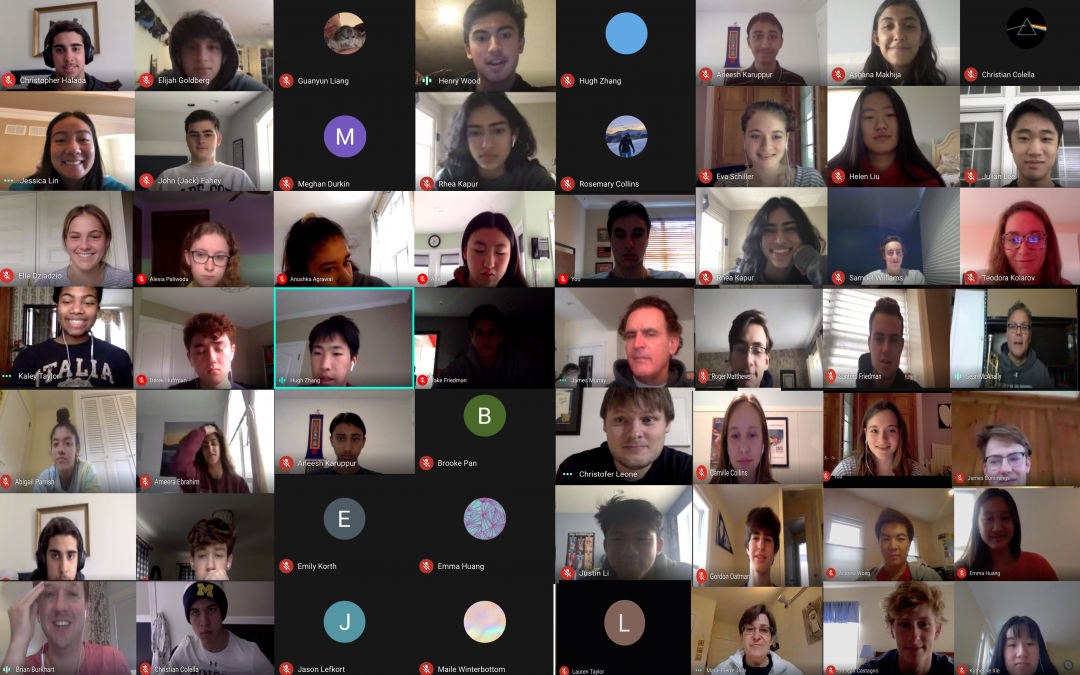
Dec 10, 2020 | COVID-19, Emily Shen, Front Page News, School News
By Emily Shen (V)
In early November, as the number of COVID-19 cases continued to spike in New Jersey and across the country, members of the Pingry community wondered whether the school would transition to fully remote learning. And it did. On November 13, Head of School Matt Levinson sent out an email to the Pingry community addressing the operational status of the Basking Ridge Campus. From that date through the week after Thanksgiving break, the Middle and Upper Schools would transition to all-online instruction. According to Mr. Levinson, this was a difficult decision based on numerous factors, including case numbers at Basking Ridge and concerns about travel during the holiday season.
Many members of the Pingry community expressed a lack of surprise by the School’s decision. Leila Elayan (V) was expecting Pingry’s decision to shift to remote learning the week before Thanksgiving due to “the steady increase in cases in the area and nationally.” Moreover, the increasing number of students who were contact-traced was another salient indication of the impending shutdown. According to Lailah Berry (V), “a lot of students and staff were contact-traced after Halloween, so going fully remote seemed like a necessary precaution,” especially with the prospect of folks visiting family over Thanksgiving break.
Last spring, Pingry transitioned to remote learning for almost a whole semester, but for many, the remote experience feels different this year. Teachers spent a lot of effort over the summer experimenting with remote learning and are now much more prepared. When asked about her classes as compared to those back in March, Sarah Gagliardi (V) said, “I think since then we’ve managed to fully adapt to the idea of learning and working remotely, because, this school year, the idea of being fully remote is not as new or surprising as it was last spring.” She continued that “because this is not the first time we’ve gone completely virtual, it has given the Pingry community more time to prepare and work out the flaws in the process.”
Although the community is more prepared this academic year, some students still find remote learning to be exhausting. As teachers assign roughly the same workload they would if students were in school, students find screen time to be one of the biggest challenges of remote learning. “Remote learning is still exhausting,” agreed Sam Wexler (V). “I spend around ten hours on my laptop pretty much every day, partially because of classes, but also because nearly all my work is online.” However, given the nature of remote learning, there isn’t a lot that the teachers can do to improve screen time exhaustion. Most teachers have adhered to the “45-minute synchronous class” rule, but asynchronous work can still get overwhelming since most materials are still online. “I would rather we just have class for the full hour and five minutes, as whatever asynchronous activity we do is always on the computer anyway,” said Kristin Osika (V).
In this era of uncertainty, members of the community have learned to appreciate the time they spend together in person. Many students who experienced both remote and in-person learning actually preferred classes to be fully remote rather than a hybrid model. “I much prefer it when everyone is home instead of the hybrid. I like it when everyone is pretty much on the same page and I don’t have to fear missing out,” said Elayan. Christine Guo (V) agreed, adding, “it was difficult to participate in class since half of us were in person and the other half were not. Once more of the class became remote, it wasn’t a problem.” Despite this, most students still hope to be together in-person again. Emma Drzala expressed that “in-person was definitely a better learning experience. Teachers could carry out more activities, especially in STEM classes.”
When discussing Pingry’s reopening plan after Thanksgiving, many were cautiously optimistic. Although the school has done everything it can to take health precautions, other factors, such as national COVID-19 case numbers and local guidelines, may affect the plan moving forward. However, although students and faculties could not all be in person, Pingry is still holding on. With the holiday season coming up, it is important to appreciate the efforts and progress that everyone is making. Stay connected and stay safe.
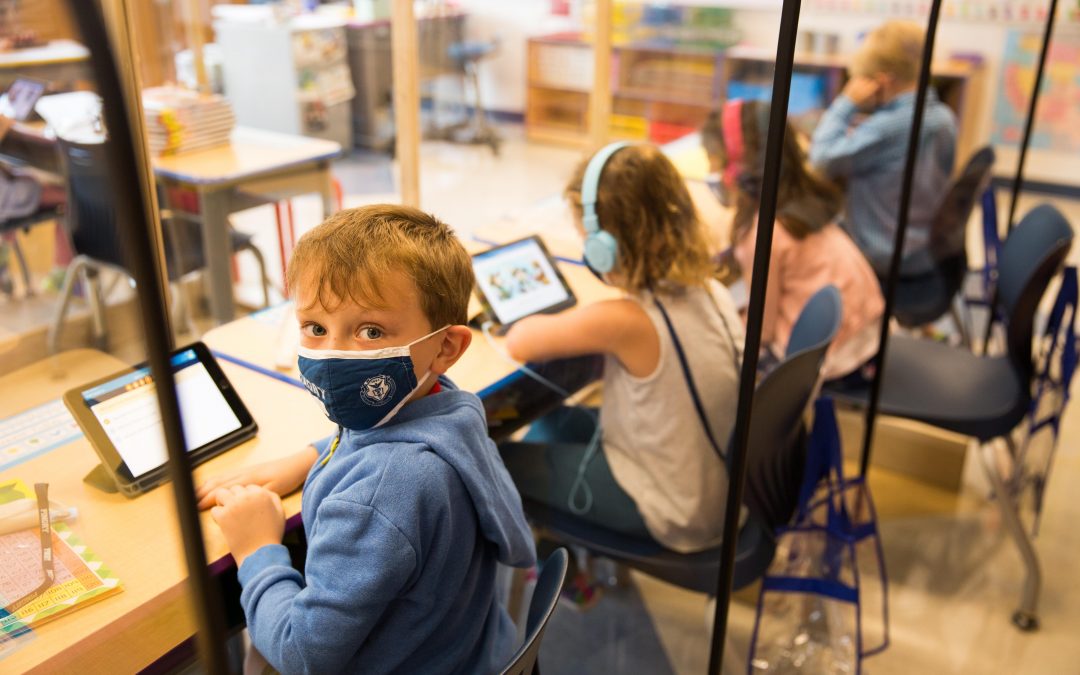
Nov 10, 2020 | Andrew Wong, COVID-19, Front Page News, School News
By Andrew Wong (V) As a tumultuous 2019-2020 school year came to an end this past June, and the COVID-19 pandemic stretched into yet another month, many members of the Pingry community were questioning if in-person learning would be possible in September. With teachers, administrators, and students desperately wanting to go back to school, Pingry Anywhere, the framework to try and facilitate school in the era of COVID-19, was created. The goal of the project was simple: get Pingry safely back in session this fall. However, it was less clear at first how this would be done. Head of School Mr. Levinson underscored the complexity of the task, summing up how Pingry Anywhere needed to “strategically [align] all dimensions of the School, from teaching and learning to technology to operations and facilities.” A leadership team, consisting of various teachers, administrators, and outside consultants, overseen by Mr. Levinson himself, was formed to manage this Herculean endeavor.
Throughout the summer, Pingry was transformed into a construction site, as facilities staff worked daily to install plexiglass safety barriers, set up massive outdoor tents, and convert the Hyde-Watson gym into a massive cafeteria. Student volunteers and faculty members spent countless hours packaging and distributing thousands of face masks and shields for the entire Pingry community. Meanwhile, the tech team installed speakers, microphones, cameras, and TV monitors in the classrooms to facilitate Pingry’s new hybrid learning model. Teachers rewrote their curricula to make sure that their plans for the year could handle both in-person and remote environments.
After a great summer-long effort, Pingry Anywhere was ready to be unveiled to the community. On September 14th, Pingry students walked back into campus to begin a school year like no other. Each student was required to fill out a pre-screening form before arriving on campus, wear a mask and shield, and try their best to spread out. Classes were hybrid, with some students joining via Zoom from home. After so many months of preparation, Mr. Levinson said of the occasion, “it was just so uplifting and gratifying to see months of planning come to fruition to bring our community back together.” Students were also extremely happy to be back.
“It was by far the oddest school day I’ve ever had,” said Dean Koenig (VI). “Seeing hundreds of faces in the same building for the first time in months, I thought there was no way in-person learning would last more than a few weeks.” While many students and faculty were initially doubtful about how long Pingry Anywhere would last, the new hybrid model proved to be extremely successful and resilient, in even the face of an uptick of local COVID-19 cases. Daily information on the spread of the virus was provided via the Pingry Anywhere Dashboard, and the addition of weekly pooled COVID testing provided by Mirimus Labs has helped to further ensure student safety.
Now almost two months into the new hybrid model of learning, Pingry Anywhere has proven to be a reliable system for learning during the COVID-19 era. As Mr. Levinson stated, Pingry Anywhere has “strengthened the sense of belonging that students feel as part of the Pingry community and has allowed us to come up with new ways of delivering on our promise of excellence.” Mr. Fahey, director of Pingry’s Health and Wellness Task Force, agreed, speculating on how “maybe the future of Pingry Anywhere is the future of education!” In the weeks that lie ahead, the limits of Pingry Anywhere will most definitely be tested, as the nation prepares for a possible winter spike in COVID-19 cases. Nonetheless, thanks to the flexibility of Pingry Anywhere, regardless of what happens, Pingry students and faculty can be assured that they will be well-protected, and the school will adjust to whatever circumstances arise.
Nov 2, 2020 | Athletics, COVID-19
By Ava Kotsen (IV)
During quarantine, many used their time to learn a new skill, spend time with their families, binge watch Netflix shows, cook, play video games, take a class online, or catch up on reading. Across the country, millions of Americans also seized this opportunity to incorporate exercise into their daily routines. However, due to lockdown and social distancing guidelines, gyms were shut down for around six months. People had to improvise by building gyms at home. Dumbbells, kettlebells, weights, treadmills, Peloton bikes, gym machines, bars, and all sorts of fitness equipment were sold out across major retailers and back-ordered for months as Americans flocked to buy any gym equipment they could get their hands on. For those who did not have thousands of dollars to drop on crafting elaborate gyms, spending time outdoors was a free and refreshing alternative.
Families went on daily strolls down the block or on bike rides through the neighborhood. These short jogs and walks helped people incorporate some structure into their lives and avoid the monotony of quarantined life. On YouTube and Instagram, free, at-home, no-equipment workout challenges from fitness influencers such as Chloe Ting, Pamela Reif, and Blogilates promised transformations such as “losing inches off your waist”, or “gaining abs in two weeks”. Those who participated were encouraged to post their progress on TikTok and Instagram as inspiration for others to follow and join.
Even though COVID-19 has entirely altered daily lives, the resilience that Americans have shown in their determination to stay fit is admirable. No matter the method of exercise, they can proudly say that they lived and survived to tell the tale of being in a global pandemic.
May 4, 2020 | COVID-19, School News
After fifty years of hosting foreign exchange students, Pingry decided to cancel its AFS (American Field Service) program for future years. This news comes alongside the fact that, over Spring Break, the current AFS program was understandably called off due to COVID-19.
The AFS program allowed a multitude of students from across the world to be a part of the Pingry community. Exchange students would stay with a host family for a year, take classes, and be introduced to a new, Pingry way of life. Through this program, students from Pingry were able to meet people from all around the world. Exchange students could engage in new American experiences, while teaching students from Pingry about their own culture.
The program also involved Pingry’s AFS Club, a student-led club that hosted welcome parties and birthday parties for exchange students. The club’s main purpose was to help exchange students acclimate with their new community. This year the club was led by Alison Lee (VI) and Massa Godbold (V), both of whom loved being a part of the club.
“I think it was very rewarding,” Lee mentioned (regarding her experience as a club leader). “This foreign exchange was very valuable to not just me, but the Pingry community. I’m sad to see it go.”
“I will miss my ability to travel abroad without leaving the comfort of the Pingry School,” said Godbold. She’ll really miss getting to know new people and making new friends, “friends that I will not soon forget and will keep in contact with for as long as possible.”
The faculty advisor for the club, Ms. Julia Dunbar, will also miss the program. “In my opinion, the best part of the AFS program is the opportunity to meet and work with students from around the world,” she said.
Pingry’s cancellation of the program was not an easy decision, and there were multiple factors that ultimately decided the program’s fate. The first was the search for host parents. “When the program began, many families were eager to host exchange students,” Ms. Dunbar remarked. “In recent years, it has become increasingly difficult to find families who are able to welcome an exchange student into their homes for an entire school year.” This is the main reason Pingry has decided to cancel the program.
The other factor was the expansion of Pingry’s global programming. AFS was one of Pingry’s first global programs, but now there are many opportunities for students to travel around the world, with immersive trips focused on a variety of subjects. Though programs have had to adapt due to COVID-19, the travel program continues to expand.
“Despite current conditions, Pingry will continue to build its global programming,” said Ms. Dunbar. “By expanding our global travel programs, global education will continue to become accessible to even more Pingry students.”
The program will be missed by Pingry students. Martine Bigos (IV) said, “I think it’s really amazing that AFS gives us the opportunity to meet incredible people from different places every year.”
This year’s exchange student was Meina Franzius (V), who came to Pingry from Germany. Even though the program was cancelled early this year, she still took a lot away from it.
“Everyone at Pingry was really nice; the teachers, the students, everybody,” she commented. She talked to me about her experience at Pingry: “It was a challenge at first, but I really enjoyed the classes. The school was totally different than my school in Germany, but I really miss it.
“We did a lot of great things. I really miss everyone.”
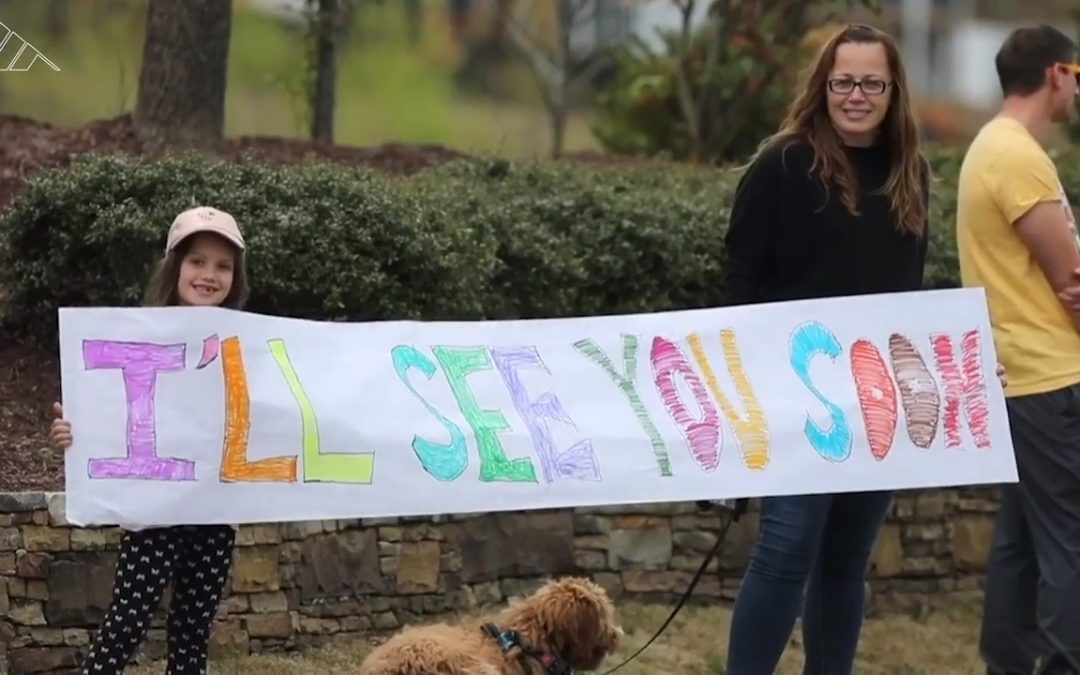
May 4, 2020 | Andrew Wong, COVID-19, COVID-19 Editorials, Editorial
By Andrew Wong (IV)
If I had to pick a headline to summarize the entire COVID-19 pandemic here in America, it would have to be “North Carolina Man Steals Truck With 18,000 Pounds of Toilet Paper”. In a close second would probably be our good friend, the Florida Man with, “Florida Man Steals 66 Rolls of Toilet Paper”. In this time of great struggle and uncertainty in our nation, and indeed the entire world, it has become evident that it is fear, not reason, that drives the decision making of not just the two aforementioned characters, but also that of the entire world. We’ve all seen the news. Videos of people fighting over the last bag of rice at the supermarket. Lines stretching out the door of big box stores. As my friends across the world can confirm, there is not a single scrap of toilet paper to be found on store shelves anywhere. People are fearful, and it is evident that hope, just like toilet paper, is nowhere to be found.
Yes, people do have a right to be scared. The statistics can speak for themselves: Over 2.6 million people have been infected globally, with more than 800,000 cases here in the US alone. The world economy has come grinding to a halt, and American jobless claims are at their highest in the last 10 years. Our everyday lives have come to a complete standstill, as everyone around the world practices social distancing to stop the spread of the coronavirus. Yet, with all of these tribulations and challenges that we face presently, there is a brighter side to this crisis — more than just the infection numbers, death toll, or economy the media keeps yapping about.
The coronavirus has brought out the best in America, a good side that many in our country did not believe exist. Our entire nation, once derided by political pundits as “hopelessly divided”, is now united in a great crusade to fight back against the coronavirus. On Capitol Hill, for what may be the first time in recent memory, Democrats and Republicans have found common ground in a bid to provide relief packages for all Americans. President Trump and New York Governor Cuomo, once bitter political enemies, now work together daily to direct government policy towards the virus. Governor Cuomo’s daily press conferences have now become regular viewing for millions of Americans trapped at home, as he continues to send messages of encouragement and positivity not just to the state of New York, but to the entire nation.
Manufacturing companies have put aside their quest for profits to retool the production lines and make much needed PPE and ventilators. America’s biotech firms have now developed testing kits that can diagnose the virus in minutes and allow for more tests to be run, while scientists in laboratories across the globe work at breakneck speed to develop a vaccine in record time before winter arrives.
Doctors, nurses, and first responders in all 50 states are working tirelessly around the clock to contain this virus. It is thanks to the valiant work of our healthcare companies and professionals that the rate of infection is no longer exponential, and as Dr. Deborah Birx, the White House Coronavirus Response Coordinator, said two weeks ago, “we’re seeing [the curve] stabilize, and that gives us great encouragement”.
Social Media, once criticized as a force that only divided society, has now become the very thing holding everyone together while we are all separated. Crowdfunding campaigns to save local businesses from the economic tsunami caused by COVID-19. In New York City alone, thousands upon thousands of dollars have been raised by New Yorkers on GoFundMe to support local restaurants and stores who have been forced to close due to the pandemic. John Kransinski, of The Office fame, publishes new videos detailing good news happening around the world on YouTube every day to try and keep people positive during social distancing. New quarantine food trends, such as Dalgona coffee and no-knead bread have become popular as a result of these easy but tasty recipes being shared on the internet. Facebook groups have been set up to help provide groceries, toiletries, and home cooked meals to the elderly in order to keep them protected from the virus.
But the coronavirus hasn’t just brought out unprecedented goodness within our communities. It’s also brought us new opportunities. While COVID-19 may have forced us all to social distance inside, this new reality presents a whole host of opportunities for us. We have been given the gift of many months of free time, so what do we do with it? How about learning a new skill, or experimenting with new recipes? What else can you do with all that stockpiled food anyways?
Perhaps you could build a healthier lifestyle and use this time to build a better you. You could finish those side projects that you never had time for, or maybe start a new lifelong obsession with a new hobby. The choice is in your hands.
There is no way to know how long we will be inside, and based on the current numbers, there will be many more months, if not a year, before things return back to “normal”. But until then, as we witness the first great global crisis of the 21st century, an event that will be forever etched into the collective memory of our generation, let us be reminded that this crisis will be over some day. As we edge closer and closer to the light at the end of the tunnel, let’s put our best foot forward and do our best to remain positive through this tumultuous time. Let’s be inspired by the acts of kindness and humanity throughout the entire world and be our best selves. Let’s not allow our fear to control us, and instead remain hopeful that there are better days ahead of us. All we have to do is stay positive, keep smiling, and just believe.

Apr 23, 2020 | COVID-19, Emily Shen, Front Page News, School News
Image by Andrew Wong (IV)
By Emily Shen (IV)
Since the conclusion of Spring Break, Pingry students and faculty members have adopted remote learning in order to follow the state-mandated social distancing guidelines. By now, they have finished their first two weeks online. Although this transition has not been easy, members of the Pingry community are working hard to resume the quest for knowledge as they try to find peace during this time of uncertainty.
According to feedback from some students, most of their classes run synchronously or by using a combination of synchronous and asynchronous sessions. Almost all of the teachers use Google Meet as the platform for “face-to-face” sessions or conversations, and most work is posted via Schoology or sent out through emails. Teachers make themselves available for help during designated time slots or during flexes and conference periods to make sure students can still seek extra help if they need to.
However, although the continuation of block schedules is supposed to help create structure, the switch to remote learning has not been an easy one for the students. Many have reported that remote learning is negatively affecting their productivity, and it often seems like there is less time for students to meet with their teachers for help. Because students and teachers are constantly interacting through their computer screens, some found that online school is more draining than typical school. Many students also report a significant increase in their workload, as well as a lack of motivation to finish it. Moreover, although teachers were guided to cut their 60-minutes periods to 45 minutes, students still spend hours in front of their computers between attending classes and school work.
Students are not alone in having to adjust to virtual classes. Many teachers also find themselves having to alter their usual way of teaching. “The biggest difference for me is that teaching is like acting or stand-up comedy. I respond to the energy of the group. When we are physically all together, I can see and feel so much more. I can tell when you are tired or sad or upset with somebody in the room. I can tell whether you understand or not, so I can adjust my response…Online, it all feels much stiffer.” said Upper School English teacher, Mrs. Grant.
For the last two weeks, teachers reported that they have gotten a little more used to the experience, but they continue to struggle with their lesson plans. “Lesson planning is very different, and it takes a lot longer. I find myself reaching out to other language teachers, exploring different sources,” said Mr. Benoit, World Languages Department Chair and Upper School French teacher, “The most complex part right now is figuring out what assessments will look like at the end of each unit or theme.” Mr. Grant, a chemistry teacher at Pingry, believes that “if learning isn’t fun, then it will be easily forgotten. We need to help students gain the skills of thinking and reasoning that they will use throughout their lives.”
When asked how they’ve adjusted to remote learning, teachers listed several examples of how they have had to adapt. “One thing I learned from my first class is that as a teacher, I hate the mute button for my students, and now I have a ‘no mute’ policy,” answered Mr. Grant. Ms. Thuzar, a computer science and math teacher at Pingry, said that she “spends more time planning and making sure that the remote learning experience for the classes is not too different from the actual in-person classes.” Although that is difficult to accomplish, Pingry students and teachers are all trying to find some peace and normalcy during this chaotic time.
Like their students, some teachers have also found remote learning to be more tiring than a typical school day. “For some reason, this is all so draining,” said Mrs. Grant when asked about her experience, “Instead of gaining energy from being with all of you, I get exhausted. I was talking with some colleagues Friday evening, and they all reported that they wanted to take a nap in between classes.” Many teachers and students end up sitting in front of the computer and barely getting up the whole day. “I feel like all the classes are all lumped together into this continuous-time span where I sit at my desk in front of my computers for hours,” Ms. Thuzar added, “For the days I teach 3 or 4 classes per day, I ended up staying in front of my computers from about 8 AM to 4 PM, excluding lunch.”
Even though the future is filled with uncertainty, spreading positivity and hope has kept us going. Mrs. Grant shared a small anecdote that cheered many of her students up: “On a positive note, since Mr. Grant and I have opposite schedules, there is non-stop teaching going on in my house right now, so my cats are soon going to be ready for college!” Similarly, Mr. Grant shared that “these are definitely strange times. I think that the most important thing that remote learning can try to achieve is our sense of community. We will get through this experience and remember these times for the rest of our lives. With this in mind, I hope we can make some good memories together.”
Please take care of yourselves and continue to spread love and positivity amongst your friends and family! Stay safe!
Apr 20, 2020 | COVID-19, School News
By Zara Jacobs (V)
In wake of the devastation of COVID-19, many people have felt a sudden urge to do something, anything to help the community heal. Even though making a thank-you video or completing a Color-A-Smile seems pointless next to the tragedies we face, “The smallest act of kindness is worth more than the grandest intention” (Oscar Wilde). The amount of time it takes to post on Instagram is the same amount of time it takes to fill out the form that sends notes of appreciation to the healthcare professionals at Morristown Memorial Hospital. Though we cannot provide a cure, there is no end to the ways we can support the people in our community.
The Community Service Council has started making Morning Meeting announcements that present volunteer opportunities, including sharing your appreciation, making sleeping mats out of plastic bags, and so many more. We urge you to at least look at the slides, if nothing else, to simply learn about what you can do to help. It can be really easy to feel helpless, especially in the context of community service. All we want to do is hug our neighbors and our friends and those who are not able to attend their loved ones’ funeral, but we can assure you is that even one thank you video will bring a smile to a doctor who has worked around the clock, putting their life at risk for the sake of the community. Calling your grandma or her friends will bring a smile to their face. When we are able to escape quarantine, we think it would be amazing if every student could come back to Pingry knowing they brought a smile to just one person’s face.










